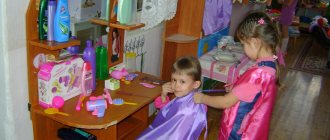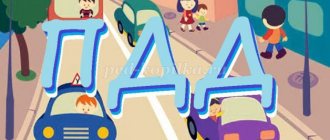excursions in the preparatory group lesson plan (preparatory group) on the topic
excursion to the post office (senior group)
Goal: To activate the vocabulary and systematize children’s knowledge about the work of postal workers.
Tasks:
1. Expand ideas about the work of adults, its necessity and social significance.
2. Expand and activate the subject dictionary, the dictionary of actions, and children’s adverbs on the topic “Professions. Postal workers."
3. Form mutual understanding, mutual assistance, and independence.
Preliminary work: Conversation about the work of postal workers, reading children's literature: S. Ya. Marshak “Mail”, A. Shibaeva “Mailbox”, looking at magazines, postcards on the topic.
Move
When you walk along the city streets, what do you see other than residential buildings? (Shops, pharmacy, etc.) And in every city there is a post office. Today we will go to the post office, meet the postal workers and see how they work.
They offer to draw pictures and see if the postman brings our letters to us or not.
(As they walk to the post office, the teacher draws the children’s attention to the rules of behavior on the street, pays attention to the sidewalk and the road.)
Teacher near the post office building
— Who knows what mail is and what it is needed for? (Children's answers.)
Look, there's a mailbox on the wall of the building.
I'm blue
Hanging on the wall
And many greetings
Is stored in me
This is a mailbox, you need to put an envelope with a letter here.
Having arrived at the post office, the teacher gives the children some time to examine on their own.
Educator: Look how big the hall is, look, the workers are working behind the counter. One is the operator. She accepts parcels, another issues registered mail, and a third sorts letters, newspapers and magazines. How do these people do their jobs?
Children: Calmly, slowly, attentively, politely talk to visitors.
Educator: Who else works at the post office, listen here
He delivers it home
A heap of letters, telegrams,
And in blue envelopes
News from friends and family?
Children: Postman
Educator: That's right, well done, postmen work at the post office. There are also sorters and a postmaster working at the post office. The sorter sorts and sorts letters, newspapers, magazines, and money orders so that the postman can correctly distribute them to the addresses. The postmaster supervises the work of all the people who work at the post office. Do your parents go to the post office? What do you think parents do at the post office?
Child 1: Yes, they do. My mother received one money order from my grandmother and two letters in the mail.
Child 2: My grandmother subscribed to three newspapers and two magazines at the post office.
Child 3: And my dad sent five greeting cards and bought five envelopes for letters to go with them.
Educator: Guys, let's ask the postmaster to see how the postman works?
(After the greeting, the postmaster accompanies the postman to the postman. The teacher reminds that you need to be quiet, not make noise, so as not to interfere with work.)
Guys, look how many newspapers and letters are on the postman’s shelves. Look, they are all different. Multi-colored and black and white. Look, there are magazines here. They are also different small and large. There are magazines for children, and there are for adults. Do you receive magazines?
Newspapers, magazines, and letters are delivered to the post office by car. And before you take everything home, newspapers, magazines and letters must be laid out like this (shows): newspapers to newspapers, magazines to magazines, but in this
a stack of letters.
How does the postman know which newspaper to put in whose mailbox? (Children's assumptions.) To do this, on each newspaper and on each magazine the postman will write the apartment number with a pencil (shows).
Look how quickly the postman signed all the newspapers. Now everything is ready and you can load the mail bag. Everything is folded and ready to be carried. Try lifting your bag. (Several children try to lift the bag.)
Postman: Well, is it heavy? Now come with me. (The children, together with the teacher and the postman, go to the hall.)
Now we need to put newspapers, magazines and letters in mailboxes. I look at the number written on newspapers and magazines and know which box to put what in.
Educator: I also keep newspapers here, so I’ll take out the key to the mailbox and open my box. Look, the postman has already given me newspapers too.
Educator: Look, one aunt decided to send a parcel.
Look, she put the things in a special box and wrote down the address where the parcel needed to be delivered. The operator weighed the parcel, sealed it with a special tape that said “Russian Post” and now this parcel can be sent on its way by train or even by plane, depending on where it needs to go.
In order for letters and parcels to withstand such a long and difficult journey and reach their addressees safe and sound, they are dressed in special clothes: letters - in envelopes, parcels and parcels - in boxes and paper.
Look how many parcels there are, and these parcels are waiting for their owners, the operators have written notices to them and are now waiting for them to come for them.
It’s true that it’s interesting here, but we’ve completely forgotten why we came here.
Children's answers
That's right, we wanted to send our drawings.
What do I need to do?
Children: Put the drawings in an envelope
Educator: Now let's buy an envelope and a stamp.
They look at the envelope and see what shape it is. The teacher draws the children's attention to the fact that the letter will not arrive without a stamp. Note the features of the stamp's appearance: rectangular shape, on one side there is a picture, on the other there is an adhesive base, it is proposed to stick the stamp on the envelope in the upper right corner.
Envelopes with packed letters must be labeled (where, to whom, from whom). If this is not done, the letter will never reach its addressee. Why do you think an unsigned letter will not reach the recipient?
Children put the letter prepared for sending into the mailbox.
Educator: Today, guys, we got acquainted with the work of a postal worker. The work of a postman is very necessary, but difficult. That's why there are many postmen working at the post office. S. Ya. Marshak wrote about the postman:
Honor and glory to the postmen, tired and dusty.
Honor and glory to postmen with a thick shoulder bag!
The teacher and children thank the postal workers and say goodbye.
Summary of the excursion to the post office for children of the preparatory group
Summary of the excursion to the post office for children of the preparatory group
Target:
Activate the vocabulary and systematize children’s knowledge about the work of postal workers.
Tasks:
1. Expand ideas about the work of adults, its necessity and social significance.
2. Expand and activate the subject dictionary, the dictionary of actions, and children’s adverbs on the topic “Professions. Postal workers."
3. Form mutual understanding, mutual assistance, and independence.
Preliminary work: Conversation about the work of postal workers, reading children's literature: S. Ya. Marshak “Mail”, A. Shibaeva “Mailbox”, looking at magazines, postcards on the topic, drawing pictures, preparing envelopes for sending by mail.
Excursion progress:
When you walk along the city streets, what do you see other than residential buildings? (Shops, pharmacy, etc.) And in every city there is a post office. Today we will go to the post office, meet the postal workers and see how they work.
I suggest drawing pictures and seeing if the postman brings our letters to us or not.
(As they walk to the post office, the teacher draws the children’s attention to the rules of behavior on the street, pays attention to the sidewalk and the road.)
Near the post office the teacher:
Who knows what mail is and what it is needed for? (Children's answers.)
Look, there's a mailbox on the wall of the building.
I'm blue
Hanging on the wall
And many greetings
Is stored in me
This is a mailbox, you need to put an envelope with a letter here
Having arrived at the post office, the teacher gives the children some time to examine on their own.
Educator: Look how big the hall is, look, the workers are working behind the counter. One is the operator. She accepts parcels, another issues registered mail, and a third sorts letters, newspapers and magazines. How do these people do their jobs?
Children: Calmly, slowly, attentively, politely talk to visitors.
Educator: Who else works at the post office, listen here
He delivers it home
A heap of letters, telegrams,
And in blue envelopes
News from friends and family?
Children: Postman
Educator: That's right, well done, postmen work at the post office. There are also sorters and a postmaster working at the post office. The sorter sorts and sorts letters, newspapers, magazines, and money orders so that the postman can correctly distribute them to the addresses. The postmaster supervises the work of all the people who work at the post office. Do your parents go to the post office? What do you think parents do at the post office?
Child 1: Yes, they do. My mother received one money order from my grandmother and two letters in the mail.
Child 2: My grandmother subscribed to three newspapers and two magazines at the post office.
Child 3: And my dad sent five greeting cards and bought five envelopes for letters to go with them.
Educator: Guys, let's ask the postmaster to see how the postman works?
(After the greeting, the postmaster accompanies the postman to the postman. The teacher reminds that you need to be quiet and not make noise so as not to interfere with work)
Guys, look how many newspapers and letters are on the postman’s shelves. Look, they are all different. Multi-colored and black and white. Look, there are magazines here. They are also different small and large. There are magazines for children, and there are for adults. Do you receive magazines?
Newspapers, magazines, and letters are delivered to the post office by car. And before you take everything home, newspapers, magazines and letters should be laid out like this (shows): newspapers to newspapers, magazines to magazines, but in this
a stack of letters.
How does the postman know which newspaper to put in whose mailbox? (Children's assumptions.) To do this, on each newspaper and on each magazine the postman will write the apartment number with a pencil (shows). Look how quickly the postman signed all the newspapers. Now everything is ready and you can load the mail bag. Everything is folded and ready to be carried. Try lifting your bag. (Several children try to lift the bag.)
Postman: Well, is it heavy? Now come with me. (The children, along with the teacher and the postman, go to the hall.) Now we need to put newspapers, magazines and letters in the mailboxes. I look at the number written on newspapers and magazines and know which box to put what in.
Educator: I also keep newspapers here, so I’ll take out the key to the mailbox and open my box, look, the postman has already put the newspapers in for me too.
Educator: Look, one aunt decided to send a parcel, look, she put the things in a special box and wrote the address where the parcel should be delivered. The operator, look, weighed the parcel, sealed it with a special tape that says “Russian Post” and now this parcel can be sent on its way by train or even by plane, depending on where it needs to go.
In order for letters and parcels to withstand such a long and difficult journey and reach their addressees safe and sound, they are dressed in special clothes: letters - in envelopes, parcels and parcels - in boxes and paper.
Look how many parcels there are here, and these parcels are waiting for their owners, our operators wrote them notices and are now waiting for them to come for them
It’s true that it’s interesting here, but we’ve completely forgotten why we came here.
Children's answers
That's right, we wanted to send our drawings.
What do I need to do?
Children: Put the drawings in an envelope
Educator: Now let's buy an envelope and a stamp.
They look at the envelope and see what shape it is. The teacher draws the children's attention to the fact that the letter will not arrive without a stamp. Note the features of the stamp's appearance: rectangular shape, on one side there is a picture, on the other there is an adhesive base, it is proposed to stick the stamp on an envelope in the upper right corner.
Envelopes with packed letters must be labeled (where, to whom, from whom). If this is not done, the letter will never reach its addressee. Why do you think an unsigned letter will not reach the recipient?
Children put the letter prepared for sending into the mailbox.
Educator: Today, guys, we got acquainted with the work of a postal worker. The work of a postman is very necessary, but difficult. That's why there are many postmen working at the post office. S. Ya. Marshak wrote about the postman:
Honor and glory to the postmen, tired and dusty.
Honor and glory to postmen with a thick shoulder bag!
The teacher and children thank the postal workers and say goodbye.
Summary of an excursion to school with children of the preparatory group
Tatiana Tikhonova
Summary of an excursion to school with children of the preparatory group
Goal: to introduce children to an educational institution - school .
Program content:
1. To consolidate children’s knowledge about school , why they need to study, who teaches what at school .
2. To form an idea of the teacher’s profession and the “profession” of the student.
3. Develop in children observation, attention, ability to listen and hear the guide (primary school )
.
4. Cultivate the ability to show initiative and curiosity in order to gain knowledge about school .
5. Create a desire to learn as much as possible about school life , a desire to study at school .
Preliminary work
1. Examination of illustrations on the topic “ School ”
2. Reading children's fiction about school life (V. Oseeva, A. Barto, E. Blaginina, etc.)
and conversations based on reading
3. Stories from adults (educators, parents)
about your studies and favorite teachers.
4. Drawing on the topic “Students go to
school ” (based on observations from everyday life)
.
5. Establish traffic rules and rules of behavior in public places.
1. Introductory part
Educator: Guys, listen to the poems and tell me what they are talking about.
Read and write
Love nature
Respect old people.
Write different letters
With a thin feather in a notebook
They teach at ... ( school )
Right. Well done! This is a poem about school .
Summer has passed. Autumn has come. The month is September. All children who turned 7 years old went to school . Do you want to go to school ? (children's answers)
Today we will go to
school , on an excursion .
2. Main part.
Educator: We came to the school
— Why do they go to school ? (children's answers)
-What do they teach at school ? (children's answers)
— Look at the school , how many floors? (children's answers)
- Yes, it is four-story, bright.
— Guys, pay attention to the porch. How wide and big it is. This is the entrance to the school .
— What is the name of the area around the school ? (children's answers)
— This is a school yard . What can you see in the schoolyard ? (children's answers: flower beds, trees)
- Who cleans the school yard ? (children's answers)
- Street cleaner!
- Well done! And who helps him? (children's answers)
— Now we will go inside the school . Who's meeting us? (children's answers)
- Yes, this is a security guard. He makes sure that strangers do not enter the school .
Next, a tour of the school is conducted by a primary school .
She introduces the children to the school : the gym, classrooms (educational, computer, music, choreography, dining room.
3. Final part.
Educator: Guys, was the excursion ?
Did you like school ? (children's answers)
In the afternoon, the children will share their impressions of the excursion with the second teacher and draw pictures “How I visited school .”





